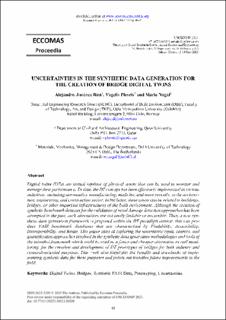| dc.description.abstract | Digital twins (DTs) are virtual replicas of physical assets that can be used to monitor and manage their performance. To date, the DT concept has been effectively implemented in various industries, including aeronautics, manufacturing, medicine, and more recently, in the architec- ture, engineering, and construction sector. In the latter, these assets can be related to buildings, bridges, or other important infrastructures of the built environment. Although the creation of synthetic benchmark datasets for the validation of novel damage detection approaches has been attempted in the past, such alternatives are not easily findable or accessible. Thus, a new syn- thetic data generation framework is proposed within the DT paradigm context, that can pro- duce FAIR benchmark databases that are characterized by Findability, Accessibility, Interoperability, and Reuse. This paper aims at exploring the uncertainty types, sources, and quantification approaches involved in the synthetic data generation methodologies and tools of the intended framework which could be used as a faster and cheaper alternative to real moni- toring, for the creation and development of DT prototypes of bridges for both industry and research-oriented purposes. This work also highlights the benefits and drawbacks of imple- menting synthetic data for these purposes and points out tentative future improvements in the field. | en_US |
